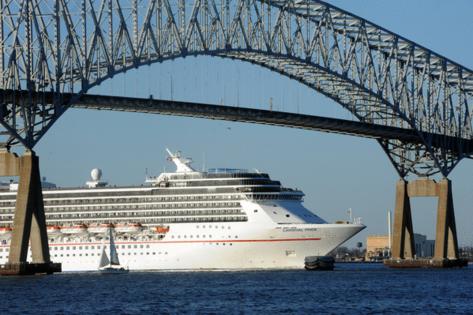As ships grow and seas rise, can Baltimore's port use new bridge to raise the roof?
Published in News & Features
BALTIMORE — Baltimore’s corner of the Chesapeake Bay has had a fixed ceiling of sorts — the 185-feet vertical clearance of the area’s bridges — for the past 70 years. Soon, authorities will decide if they want to raise that limit and by how much.
It’s a once-in-a-century opportunity, a decision that will define the vertical limits of the corridor for decades. Determining an optimal height for market and societal needs generations from now requires collaboration from state and federal entities, harbor pilots, and Baltimore Gas and Electric Co. — as well as predicting the size of ships and the rise of sea levels over the decades to come.
The Bay Bridge near Annapolis opened at roughly 185 feet in 1952. When another span was added in 1973 and the Key Bridge constructed in 1977 in Baltimore, each was built to about the same height. To date, that’s been sufficient for the Port of Baltimore’s cargo and cruise industries.
But with an eye to the future, owners of other bridges leading to East Coast ports have raised — or are considering raising — their bridge clearances, despite the high costs of doing so.
Potential builders submitted proposals by a Monday deadline to replace the Key Bridge, which collapsed March 26 when it was stuck by a container ship. The state of Maryland will select a winning team by the end of summer. That means that during the 150-year period from 1952 to well past 2100, this is likely to be the most opportune time to make a permanent change to Baltimore’s “ceiling.”
Too low and it could jeopardize the port’s future commerce, if shipping lines redirect cargo to rival ports with higher clearances. Too high and it needlessly increases construction costs and potentially makes for more dangerous conditions for vehicle drivers on the bridge deck.
Increasing the shipping channel’s ceiling also means computing its floor: Chesapeake Bay waters are expected to rise between 3 and 5 feet by 2120, according to a federal task force on sea-level rise. That’s higher than the global average.
The new Key Bridge, projected to open in 2028 and cost $1.7 billion, will be built to have a minimum of a 75-year life, although some engineers project it will stand at least 100 years. Meanwhile, the older of the two Bay Bridge spans only has about 15 or 20 years of life left so it, too, will need to be replaced. A new Bay Bridge almost certainly would be made to the same height as the new Key Bridge and that span would, similarly, be built to last more than 75 years.
Vertical clearance — the space between the water and the bottom of a bridge’s roadway — is one of many factors that will be decided as state officials work with a selected Key Bridge builder.
“We’re in the middle of that process right now — looking at the market today, the future market, what’s happening in the industry, and what makes sense for the Port of Baltimore,” Maryland Transportation Secretary Paul Wiedefeld said in an interview earlier this month.
...continued
©2024 The Baltimore Sun. Visit at baltimoresun.com. Distributed by Tribune Content Agency, LLC.







Comments